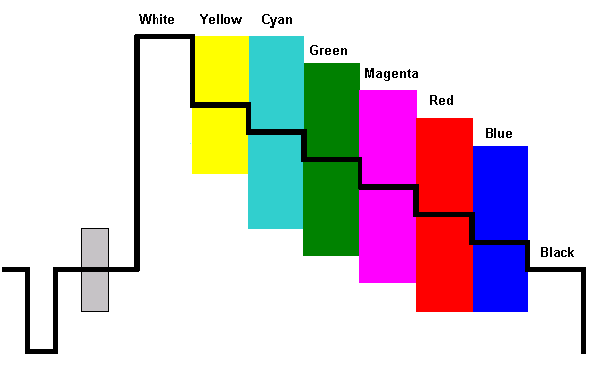Television: Color  |
|
Additive Color Mixing color light is called additive color mixing, because
the combined colors are formed by the adding of light from two or more light
sources together, ... |
| Circuits luminance
chrominance en Français |
|
Color bars and how To use them NTSC Color Bars |
|
Color burst
NTSC, pdf file |
|
Color CRTs
Spectral response of Cathode Ray Tubes |
| Color perception,
images, animation ppt file |
|
Colour and contrast in display
technology |
|
Colour rendering of spectra |
|
Color
Representation Visible Light Spectrum, Color Matching, Trichromatic Color
Theory, Psychophysics, CIE standard, RGB and CMYK Color Spaces, HLS Color Model |
| Color spectrum
references by Scott Ed |
|
Color television fundamentals (NTSC) Video Basics - Luminance and
Chrominance, Transmission Signals in NTSC Video and the reduction of Color
Detail, Computing Y, I and Q from Luminance and Chrominance in NTSC Video, This
I and Q stuff is confusing. Why did they do it this way? |
|
Color Vision
Human perception of different wavelengths of light |
|
Colour-temperature and
whitepoints |
|
Eye cone respons
human eye spectrum |
|
Eye cone respons |
|
Eye cone respons |
|
Guide to comb filters: Y/C separation pdf file |
|
Introduction to Colour
Science |
|
Monitors - TV - colors
Computer monitors and televisions make use of the 3 primary colors of mixing
light. The amazing thing about these video screens is that they are composed of
thousands or even millions of very tiny dots or stripes of red, green, and blue,
..., Primary Colors- Additive and Subtractive |
|
NTSC color
signal |
|
NTSC/PAL
decoder pdf file |
|
NTSC/PAL Video Decoder pdf file |
|
NTSC
Video Measurements |
| RCA
Color Television System Requirements for Compatible Color Television Systems |
|
RGB color model The RGB color model is an additive model in which red,
green, and blue (often used in additive light models) are combined in various
ways to reproduce other colors, ... |
|
Subtractive color
Subtractive mixing takes place whenever any two or more colors of paint, marker,
ink, or dye are mixed together, ... |
|
Television screen pattern
Television screen pattern |
|
Horizontaal |
Television: composite video signal  |
|
Anatomy of a video signal Video Scanning, Analog Video Signals, Analog
Standards, Digital Video Signals |
|
Characteristics of B,G/PAL and M/NTSC television systems
PAL, NTSC system |
| Composite TV signal |
|
Composite TV signal
the fundamentals of analog video, Interlaced scanning system, Visual Resolution
in Television Systems, Y, B-Y, R-Y: Luma and color-difference signals, composite
video signal |
|
Composite
video signal Composite video signal |
|
Composite Video Separation
Techniques pdf file |
|
Component Video Sync
Formats Television Broadcast Systems, PAL system, NTSC sysrtem, PAL
Composite video, NTSC Composite video, pdf file |
|
NTSC Video Measurements The Basics Basic Video Testing — Waveform Monitor
Techniques, Checking Chrominance Phase, Checking Chrominance Gain, Checking
White Balance, pdf file |
|
PALplus
Television Systems, Enhanced 625-line Phased Alternate Line (PAL) television,
PALplus system, pdf file |
|
Pal systems pdf file |
|
Television Measurements - NTSC pdf file |
|
Television Measurements -
PAL pdf file |
|
Understanding Analog Video Signals |
|
Video Comb Filters
Video Comb Filters, Comb filters are widely used in video circuits to separate
the luminance signals from the color signals |
|
Video pattern generator zip file |
|
Video resolution: an overview number of scan lines, or vertical resolution,
of NTSC/PAL/SECAM, horizontal resolution, digital TV and HDTV |
|
Video Signal
Formats |
|
Video Signal Measurement
and Generation Fundamentals |
| Video
signal standards
composite video, S-video, S-VHS, RGB, NTSC, PAL and SECAM |
|
YUV(YCbCr) to RGB
converter |
|
Horizontaal |
|
|
PAL video color signal: |
|
 |
|
|
Home
|
Site Map
|
Email: support[at]karadimov.info
Last updated on:
2011-01-02
|
Copyright © 2011-2021 Educypedia.
http://educypedia.karadimov.info
|
| |